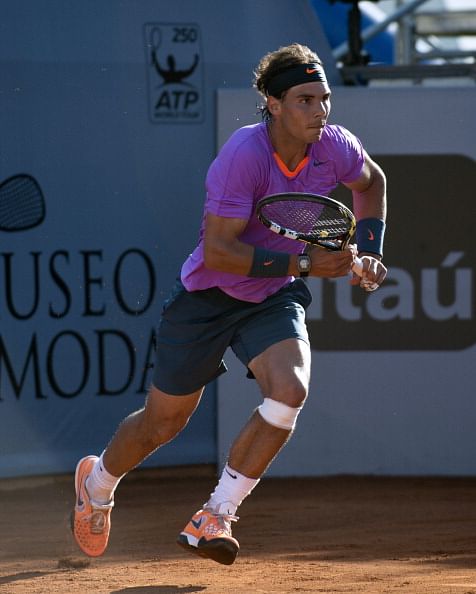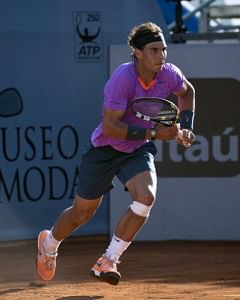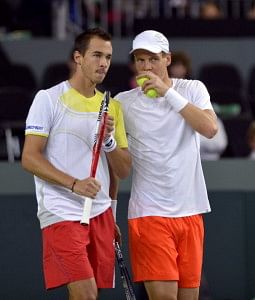
Rafael Nadal keeps tennis in the news, while Davis Cup continues to exist
It’s been nearly two weeks since the Australian Open ended, and tennis has actually managed to stay in the news during this time. How has such an unbelievably astonishing turn of events come to pass? The romantic in me wants to say ‘Davis Cup‘, but romance has never really stood much of a chance against reality. At least not in my book. On that sombre note, let’s take a look at what’s been happening in the post-Melbourne tennis world, starting with the thing that’s been chiefly responsible for keeping the sport in the news:
 Rafael Nadal is back, even if his knees might not be
Rafael Nadal is back, even if his knees might not be
The much-awaited comeback of Rafael Nadal finally happened this week. Appropriately, the comeback came on clay, but a little less appropriately, it occurred in the far-flung Chilean city of Vina del Mar. Before you ask ‘Why Vina del Mar?’, though, think about the situation for a minute or two. This is Rafael Nadal we’re talking about. It wouldn’t befit the King of Clay to make his grand return anywhere other than on clay; not by a long mile. And what’s the first clay event of the year on the ATP schedule? The quaint little VTR Open housed along the sandy beaches of picturesque Vina del Mar. As Mahendra Singh Dhoni would say, “well, of course”.
Nadal didn’t take too long to get back into his groove. He first stepped on the court for his doubles match with Juan Monaco (which the pair won routinely), and a day after that, played his first singles match in more than seven months, against qualifier Federico Delbonis. While he did go down an early break, his forehand found some of its lost sting in almost no time, and that was enough to shut the door on the hapless Delbonis before anyone could even mutter ‘upset’. He plays his third round match against Daniel Gimeno-Traver later today, and by this point it already seems sacrilegious to think of anyone but the Spaniard lifting the trophy on Sunday.
That’s the good part. The bad part, as it always does with Rafa, begins and ends with the k-word. The man himself has steadfastly refused to give away too many details about the state of his knees, waving off reporters with statements like, “My knee is much better…but it’s still bothering me, which will keep me from playing all the time, which I would like to do.” Is it just me, or has Nadal become really good at giving diplomatic comments? There was a time when he struggled to put two sentences together in a language that was distinctly alien to him; now, he’s running circles around the most accomplished native speakers with his long-winding statements and clever choice of words.
The bigger question, though, is whether we should be losing sleep at all over Rafa’s mysterious ways. As his press conferences get more convoluted by the day, it is perhaps a sign for the tennis-watching world that deciphering his comments is far less important than reveling in the fact that he is on the court and healthy enough to put racquet to ball.
Like every great champion of the sport, Nadal brings something unique to the table, something that we’ve only just realized we’ve been sorely missing for the past seven months. What would you rather do: spend hours trying to figure out whether or not his knees will hold up for the rest of the year, or sit back and enjoy the irresistible spectacle of his earthy brand of tennis? I don’t know about you, but the latter option sounds a LOT more agreeable to me.
******************************************************************
 Davis Cup continues to flourish (or should that be ‘continues to exist?’)
Davis Cup continues to flourish (or should that be ‘continues to exist?’)
We’ve all heard the arguments and counter-arguments to death. Davis Cup is a unique competition worthy of being treasured, vs Davis Cup is an irrelevant event that has outlived its usefulness. Last week’s action seemed like a perfect advertisement for the format; you could almost hear the pro-camp shouting ‘Score 1 for Davis Cup!’. Tomas Berdych and Lukas Rosol battled against Stanislas Wawrinka and Marco Chiudinelli for 7 long hours – this was the second-longest professional tennis match ever played – and all anyone could talk about was how Davis Cup brings out the very best of the players.
But should we allow these occasional epics to cloud the fact that the tournament demands an enormous workload from the players in an already overcrowded calendar? Yes, you can chalk me up among the anti-Davis Cuppers. Sure, the tournament is an integral part of tennis tradition; its history is both rich and poignant. And there’s also no denying that for many players, making their country proud in a well-recognized tournament is akin to winning a Slam. But with top players like Nadal complaining about the calendar nearly every day and others like Roger Federer surreptitiously removing tournaments from their schedule to elongate their careers, having a year-long team competition just sounds like a recipe for pain.
Consider this: Novak Djokovic played his heart out in Melbourne, overcoming all kinds of physical issues and dogged opponents to capture his 4th Australian Open title. And within 4 days of that, he had to travel half-way across the globe to join his teammates in their attempts to quell hosts Belgium and progress to the quarterfinals. Djokovic did admirably well, helping his country register a 3-2 victory. But the bottomline is that the World No. 1 had to stretch his endurance levels yet again, and for something that will not add anything to his legacy whatsoever. Shouldn’t there be a rule, on humanitarian grounds alone, to prevent something like that?
There have been suggestions from some quarters that the Davis Cup should follow the Hopman Cup model. I, for one, wholly endorse that idea: turning the Davis Cup (and its slightly less illustrious cousin, the Fed Cup) into a start-stop, exhibition style event will not only lighten the players’ workloads considerably, it will also make the whole thing a lot more fun to watch. There, I said it. Davis Cup is boring. And while I’m at it, I’ll also go ahead and say that the very core idea of the tournament is flawed; tennis is an individual sport, not a team one, and it’s not fair to penalize a few players just because their teammates were not up to scratch (David Nalbandian, anyone?).
Now it’s obvious that these two reasons, even if they are voiced by a significant proportion of the tennis populace, are a little too subjective (or born out of personal bias) to prompt any serious initiative to scrap the tournament. But the current, more burning issue – the unnecessary burden placed on the players – is something that demands attention. Particularly when you consider that almost every second ATP tournament these days leaves behind in its wake a long line of beat-up, broken-down war veterans.
Maybe abolishing the tournament altogether would be too radical a step. As much as I hate half-measures, perhaps half-measures is the way to go here: carving out a special place for Davis Cup in the calendar, preferably in the off-season. Wouldn’t the tennis world be a much happier place if players only had to report for Davis Cup duty once in the year? I’m sure Rafael Nadal’s knees, if nothing (or no one) else, would agree.